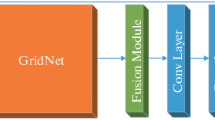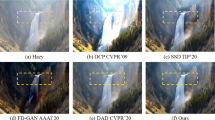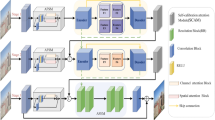Abstract
Images captured under complicated weather conditions, such as haze, often suffer from a noticeable degradation and hamper its practical application. Traditional dehazing methods use various hand-crafted priors to get a clear image; in such cases, the performance is limited owing to unconstrained environment. In order to restore the haze-free image directly, we propose an end-to-end Gated Residual Feature Attention Network (GRFA-Net) that leverages the haze representations through feature restacking and propagation. We design a Feature Attention Residual Block (FARB) as the core of feature extraction, which employs the residual block to extract hierarchical features, and followed by a novel Feature Attention Module (FAM) that adaptively captures the inter-dependencies from channel- and spatial-wise perspectives. Furthermore, we utilize a group structure (GS) to enlarge the receptive field and merge different multi-level features via the gate fusion module (GFM), respectively. Extensive experiments demonstrate that our GRFA-Net can obtain results that are comparable or even better than previous state-of-the-art methods in terms of quantitative and qualitative evaluation metrics. Furthermore, we reduce the computational complexity considerably and obtain a real-time FPS. The code is available: https://github.com/leandepk/GRFA-Net.










Similar content being viewed by others
References
Redmon J, Farhadi A (2018) Yolov3: An incremental improvement. arXiv:1804.02767
Liu W, Liao S, Ren W, Hu W, Yu Y (2019) High-level semantic feature detection: A new perspective for pedestrian detection
Ma C, Yang C, Yang F, Zhuang Y, Xie X (2018) Trajectory factory: Tracklet cleaving and re-connection by deep siamese bi-gru for multiple object tracking. In: 2018 IEEE International Conference on Multimedia and Expo (ICME)
Ma C, Li Y, Yang F, Zhang Z, Xie X (2019) Deep association: End-to-end graph-based learning for multiple object tracking with conv-graph neural network. In: the 2019
McCartney E J (1976) Optics of the atmosphere: scattering by molecules and particles. nyjw
Narasimhan S G, Nayar S K (2000) Chromatic framework for vision in bad weather. In: IEEE Computer Society Conference on Computer Vision & Pattern Recognition
Narasimhan S G, Nayar S K (2002) Vision and the atmosphere. Int J Comput Vis 48 (3):233–254
He K, Sun J, Fellow, IEEE, Tang X (2011) Single image haze removal using dark channel prior. IEEE Trans Pattern Anal Mach Intell 33(12):2341–2353
Ancuti C O, Ancuti C (2013) Single image dehazing by multi-scale fusion. IEEE Trans Image Process 22(8):3271–3282
Zhu Q, Mai J, Shao L (2015) A fast single image haze removal algorithm using color attenuation prior. IEEE Trans Image Process 24(11):3522–3533
Fattal R (2014) Dehazing using color-lines. Acm Trans Graph 34
Fattal R (2008) Single image dehazing. Acm Trans Graph 27(3):1–9
Hautiere, Tarel, Aubert (2007) Towards fog-free in-vehicle vision systems through contrast restoration. In: IEEE Conference on Computer Vision & Pattern Recognition
Xie B, Guo F, Cai Z (2010) Improved single image dehazing using dark channel prior and multi-scale retinex. In: International Conference on Intelligent System Design & Engineering Application
Berman D, Treibitz T, Avidan S (2016) Non-local image dehazing. In: 2016 IEEE Conference on Computer Vision and Pattern Recognition (CVPR)
Cai B, Xu X, Jia K, Qing C, Tao D (2016) Dehazenet: An end-to-end system for single image haze removal. IEEE Trans Image Process 25(11):5187–5198
Ren W, Liu S, Zhang H, Pan J, Cao X, Yang M H (2016) Single image dehazing via multi-scale convolutional neural networks
Ren W, Ma L, Zhang J, Pan J, Cao X, Liu W, Yang M H (2018) Gated fusion network for single image dehazing
Qu Y, Chen Y, Huang J, Xie Y (2019) Enhanced pix2pix dehazing network. In: 2019 IEEE/CVF Conference on Computer Vision and Pattern Recognition (CVPR)
Qin X, Wang Z, Bai Y, Xie X, Jia H (2019) Ffa-net: Feature fusion attention network for single image dehazing
Li B, Peng X, Wang Z, Xu J, Dan F (2017) Aod-net: All-in-one dehazing network. In: 2017 IEEE International Conference on Computer Vision (ICCV)
Chen D, He M, Fan Q, Liao J, Zhang L, Hou D, Yuan L, Hua G (2019) Gated context aggregation network for image dehazing and deraining. In: 2019 IEEE Winter Conference on Applications of Computer Vision (WACV). IEEE, pp 1375–1383
Liu X, Ma Y, Shi Z, Chen J (2019) Griddehazenet: Attention-based multi-scale network for image dehazing. In: Proceedings of the IEEE International Conference on Computer Vision, pp 7314–7323
Lin H Y, Lin C J (2017) Using a hybrid of fuzzy theory and neural network filter for single image dehazing. Appl Intell
Singh D, Kumar V, Kaur M (2019) Single image dehazing using gradient channel prior. Appl Intell 49(8)
Krizhevsky A, Sutskever I, Hinton G (2012) Imagenet classification with deep convolutional neural networks. In: NIPS
Simonyan K, Zisserman A (2014) Very deep convolutional networks for large-scale image recognition. Computer ence
Szegedy C, Liu W, Jia Y, Sermanet P, Reed S, Anguelov D, Erhan D, Vanhoucke V, Rabinovich A (2015) Going deeper with convolutions. In: Proceedings of the IEEE conference on computer vision and pattern recognition, pp 1–9
He K, Zhang X, Ren S, Sun J (2016) Deep residual learning for image recognition. In: Proceedings of the IEEE conference on computer vision and pattern recognition, pp 770–778
Howard A G, Zhu M, Chen B, Kalenichenko D, Wang W, Weyand T, Andreetto M, Adam H (2017) Mobilenets: Efficient convolutional neural networks for mobile vision applications
Itti L, Koch C (2001) Computational modelling of visual attention. Nat Rev Neuroence 2 (3):194–203
Itti L (1998) A model of saliency-based visual attention for rapid scene analysis. IEEE Trans 20
Mnih V, Heess N, Graves A, Kavukcuoglu K (2014) Recurrent models of visual attention. Adv Neural Inf Process Syst 3
Hu J, Shen L, Albanie S, Sun G, Wu E (2017) Squeeze- and-excitation networks. IEEE Trans Pattern Anal Mach Intell PP(99)
Vaswani A, Shazeer N, Parmar N, Uszkoreit J, Jones L, Gomez A N, Kaiser L, Polosukhin I (2017) Attention is all you need. In: Advances in neural information processing systems, pp 5998–6008
Woo S, Park J, Lee J Y, Kweon I S (2018) Cbam: Convolutional block attention module
Hu X, Fu C W, Zhu L, Heng P A (2019) Depth-attentional features for single-image rain removal. In: 2019 IEEE/CVF Conference on Computer Vision and Pattern Recognition (CVPR)
Ulyanov D, Vedaldi A, Lempitsky V (2016) Instance normalization: The missing ingredient for fast stylization
Zhang X, Wang T, Luo W, Huang P (2020) Multi-level fusion and attention-guided cnn for image dehazing. IEEE Trans Circ Syst Video Technol PP(99):1–1
Li G, Zhang M, Zhang Q, Chen Z, Liu W, Li J, Shen X, Li J, Zhu Z, Yuen C (2019) Psdnet and dpdnet: Efficient channel expansion, depthwise-pointwise-depthwise inverted bottleneck block
Zhang X, Zhou X, Lin M, Sun J (2017) Shufflenet: An extremely efficient convolutional neural network for mobile devices
Zhang H, Patel V M (2018) Densely connected pyramid dehazing network
Lin T Y, Dollár P, Girshick R, He K, Hariharan B, Belongie S (2016) Feature pyramid networks for object detection
Li B, Ren W, Fu D, Tao D, Feng D, Zeng W, Wang Z (2017) Reside: A benchmark for single image dehazing. arXiv:1712.04143 1
Boyi, Li, Wenqi, Ren, Dengpan, Fu, Dacheng, Tao, Dan, Feng (2018) Benchmarking single-image dehazing and beyond. IEEE Trans Image Process
Yang D, Sun J (2018) Proximal dehaze-net: A prior learning-based deep network for single image dehazing. In: European Conference on Computer Vision
Liu X, Suganuma M, Sun Z, Okatani T (2019) Dual residual networks leveraging the potential of paired operations for image restoration. In: Proceedings of the IEEE Conference on Computer Vision and Pattern Recognition, pp 7007–7016
Huang P, Zhao L, Jiang R, Wang T, Zhang X (2020) Self-filtering image dehazing with self-supporting module. Neurocomputing
Acknowledgements
This work was supported by the Beijing Key Laboratory of Precision Photoelectric Measuring Instrument and Technology, the National Natural Science Foundation of China (Grant No. 6130119) and the National Natural Science Foundation of China (Grant No. 61475018) and the Winter Olympics Key Project Technology Fund (2018YFF0300804).
Author information
Authors and Affiliations
Corresponding authors
Additional information
Publisher’s note
Springer Nature remains neutral with regard to jurisdictional claims in published maps and institutional affiliations.
Rights and permissions
About this article
Cite this article
Yi, W., Dong, L., Liu, M. et al. Gated residual feature attention network for real-time Dehazing. Appl Intell 52, 17449–17464 (2022). https://doi.org/10.1007/s10489-022-03157-4
Accepted:
Published:
Issue Date:
DOI: https://doi.org/10.1007/s10489-022-03157-4




